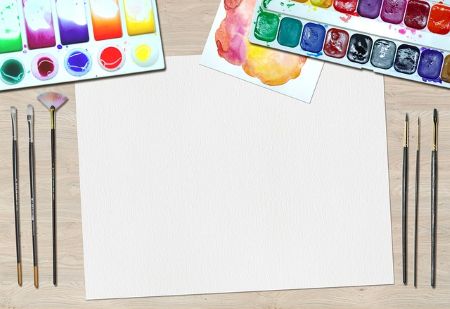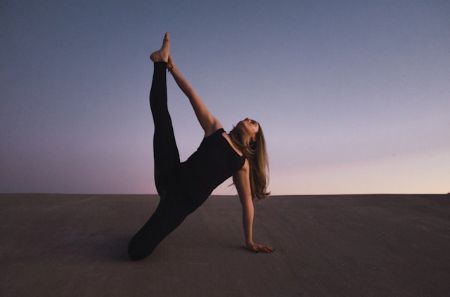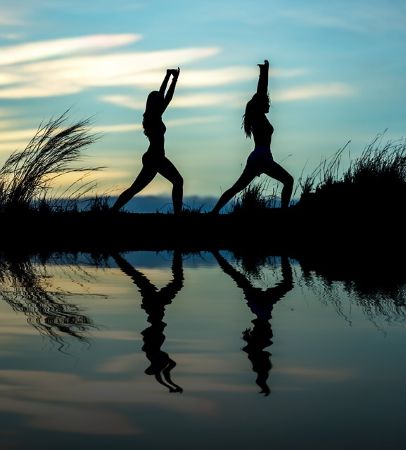Everybody remembers their first dance. A tender artistic expression of a coming-of-age moment, or the first nervous steps marking the start of a transition into something new. Through the artistry of dance, we define our passage into profundity and the curiously emotional. We unleash an urge that extends far beyond our mortal bodies – a craving to express the depths of our souls.
The first dance I remember wasn’t that of an awkward school disco, nor of any acts of frivolous hedonism. It wasn’t even my first dance with my husband at our wedding.
My first dance was more private than that.
It was with myself, on my Yoga mat.
It was the first time I truly moved beyond the confines of my physical body, completely detaching from and surrendering all conscious thought. Completely absorbed by an ensorcelled rhythm and cadence, through the movements of my form, my soul painted a loud, lyrical message.

Shifting shapes through dimensions and planes, every handprint and foot stamp marked an ordinarily elusive moment. It was during this first accidental ‘dance’ I achieved a greater union with myself in all my raw, immaterial guises – mind, body, and spirit.
Within the totality of anoesis, I discovered the hidden art of Asana.
Becoming Art
Unknowingly, this phenomenon was something I’d experienced before. Entrenched within the arts, I spent my formative years on stage and screen, embodying other characters. I’d matriculated through my teenage years maniacally throwing paint at canvases and furiously etching the secrets of my soul into any surface at my disposal.
In these moments and spaces, I eluded my own consciousness. Slipping through the neon buzz of life’s matrix, I arrived in a blissful void, where my soul could truly be free.
Truthfully, a natural flair for art wasn’t the impetus to the artistry achieved on my mat. Any prior creative endeavours were just humble parts of the process. Blindly, I didn’t notice them because I didn’t know what I was looking for. I needed to feel the experience of unfiltered ecstasy and sheer abandonment of conscious self before I could understand what happened before it. I needed to find Yoga to truly understand what it was to become art.
Redirected To The Moment
Like with all spiritual paths, the best lessons learned are seen in retrospect but found in the present moment.
Yoga’s true art is an unwavering allegiance to the ‘moment’.
Each past moment a pivotal point for learning. Each present moment an opportunity for our souls to exercise their understanding of what’s resonating within and around the other layers of self.
Movement is a key part of that learning and understanding process. Embracing Asana practice is often regarded in the space as surplus and an act of vanity – a step of the path feebly adopted by westerners to fulfil superficial needs.
But it’s through the material medium of our bodies that we make our clearest communications – both externally and internally.
Through all the lissom and liberation of moving our bodies, we free the mind. We tune into habitual motions and rhythms that ripple through our souls. We dissolve into the moment and permit space for the distractions of life to melt away. As the illusion of life drips from our floating bodies, we suffuse ourselves within a space that’s our own reality. The messages of our souls are liberated and clear for all to hear.

As we dance and splash our bodies about our mats, the fire and frenzy of the world around us is dampened. The chaos of life is suspended beneath the tip-tap of toes and baritone of breath.
In the paradox of disengaging our chaotic conscious minds, we actualise the yearnings of Self. We break boundaries, dissolve dimensions and subvert all we think we know and understand through the art of Asana.
Art In Motion
In all its flexuous glory, it’s hard to imagine the physical portion of a Yoga practice was once a humble preparatory act for greater feats.
Even though Yoga originated as a non-ecclesiastical system of philosophy in the East, it’s transplantation to the west shaved away its philosophical layers. The concept of Yoga comprises eight ‘limbs’ – or steps to enlightenment – but we tend to favour just one or two, particularly Asana.
Originally designed to steady both body and mind in preparation for many hours of seated meditation, Asana actually works on a subatomic level, much like the profundity of any art form. Music, poetry, dance, and visual arts all involve the mechanics of the physical body as a tangible means to our soul’s ultimate goal.
Only when the thread connecting all our layers – physical, emotional, and spiritual – is strengthened and tightened can we achieve pure artistic expression. Priming the body is an important part of Yoga’s artistry and the expansive practice of Asana supports us to communicate inaudible messages linking together the layers of who we are.
With limbs flung in every direction, rubbery bodies make for the elastic souls we need to navigate the frenzy of modern life. The whispers of our hearts reverberate over the chatter of our minds and the tacit demands of the world. Like a painter approaching their canvas, Asana allows us to prepare for the moment when we transcend earthly stimulation and simply be.
Losing focus, we regain control.
Abandoning our minds, we think clearer and with more concision. We draw conclusions without expectations and determine the concepts, ethics, and beliefs that truly connect with who we are.
The artistry achieved by our bodies acts as a substrate to bond what we can make sense of – our physical beings – with the dissolute mysteries we attain to – inner peace and ultimate bliss.
Vehicle For The Soul
On the surface, it’s easy to assume that Yoga is a process that glorifies the body. It isn’t so much that it lauds the physical form but rather respects its faculty as a vehicle for the soul.
Aside from this, the body is inherently designed to express and communicate its inner conversations to the wider world. Our communication modalities are subtle but insanely powerful for exposing real truths. Our explicit and implicit movements – including scientifically deductible registrations like paralinguistics – tell tales of what’s bubbling beneath our surfaces.

Some things are difficult to communicate, and we might not even realise we have all these things to unbridle until we take to our mats and dive deep within.
As we do, our messages resound within our emotional layers, and we breakout in an ecstatic performance of postures meaningful to us. This visual choreography of movement paired with the intention of our messages is pure artistic practice.
Exploring The Unexplainable
Art is a confounding conduit for communicating the things that linger at the tips of our tongues. The thoughts, feelings, beliefs, and opinions locked tightly in the chambers of our hearts. Art is what supports us to make even a fraction of sense of the eternally omnifarious world around us.
Yoga does this too. Enigmatically, it helps us calculate both our inner worlds and the outer world without ever actually finding a solid answer or explanation to any of our questions. Just like other visual arts.
The moments when our bodies are less intuitive, and expression is less intrinsic are equally as important to our journey and serve enormously to our always-dormant artistic beings. Sometimes our hearts and souls are muffled by the world around us, and we simply need to react to our environments. It’s crucial to acknowledge these quieter moments. It’s not a sign we’ve fallen out of synchronicity with our inner voices, nor that all the work we’ve done is unravelling, it’s more proving that our practices are working.
Respecting and responding to the world around us in a productive and positive way – however that is visually represented – proves we’re absorbed in the moment and are, therefore, living aligned with Yoga.
Asana supports us to understand the purpose of our existence. The feelings we attribute to our bodies in fact shine lights on deeper issues within us – traumas and negative experiences blistering upon our souls.
Divine Dusting
Subversive modern artist Balthasar Klossowski de Rola – known as Balthus – said of painting “…is a source of endless pleasure, and of great anguish.” Recognising the duality of art, operating within each branch of the soul – the ego and the authentic self – synergistically laundering them to achieve a state of pure bliss. Of which, we can perhaps relate Pablo Picasso’s quote “the purpose of art is washing the dust off our daily lives” to mean.

In a way, Yoga is predicated on a need to cleanse the grime placed upon us by the structures and limitations of the conscious mind. Since our minds directly manifest through physical planes, it’s logical that we assign our bodies the task of working through these blockades.
The canvas for which we can excavate our embedded issues explode with colour. As our internal and external conversations are embodied, the result is a seismic shift in perception of who we are and our place within the world – and deeper consideration of what existence means to us. The more we practice with instinct and fluidity – splattering our inner thoughts and desires across our mat-based canvases, the louder those conversations become. The paint gets messier, and the colours get brighter, but our messages are clearer and the inner workings of our hearts, minds, and bodies are displayed for the universe to see.
The creative component of Yoga – Asana practice – often feels fleeting and impossible to grasp.
Some things escape words and definitions. And the moment Asana practice becomes an art form is one of those things. Yoga is a powerful language that offers no explanation, only direction. Through purposeful, andante movements, we communicate our soul’s entrenched desires with the wider universe.
Asana also supports us to understand the purpose of our existence. The feelings we attribute to our bodies in fact shine lights on deeper issues within us – traumas and negative experiences that we unfairly (but understandably) lambast ourselves for. But our physical beings are important and should be treated like the fine art works they are.

Whatever shape, size, or colour; no matter what imperfections and deficits society tells us we have, our bodies are incredible mediums for embodying deeper concepts. Whether that’s through how we model them, or the words they write and the songs they sing, they have the power to alter our experiences of the world.
Eurythmic in expression, our bodies become instruments and mediums for connecting with the consonance of greater existence – the divine harmony, intangible and unfathomable, but omnipresent and only ever an Asana practice away.
Needlepoint Philosophy
Asana is an expedient supporting us to discern the wider concepts and applications of the totality of a holistic Yoga practice. Through physical movement, we step into enactment of quiet reflection. It might feel purely physical, but the benefits far transcend exercise and range of flexibility.
As we vacillate and delineate our own interpretations on our mats, we seal the last link in a concatenation that, when missing the alchemical art of Asana, would be a messy map of things we simply pretend we understand.
Asana meets our physical needs, helps us feel safe, establish belonging, and build self-esteem, all leading to self-actualisation and attainment of a higher reality. A process many artists navigate too.
We might avoid admitting it, asana is the needle that stitches together the other layers of the Yoga system. Mediumistic, it provides a central point for us to come back to. It’s relatable and allows us to reason with the concepts of the other steps in a practical way.
We’re kinetic beings & our bodies are designed to move.
It’s how we learn about and connect with all the themes of the world and mysteries of the universe. Just like if we could hold the stars, we’d feel more connected to the space enveloping us.
Asana is a platform for that interaction and relationship with what we have little tangible experience within, and knowledge of. We can read all the books we like but if we can’t see it, smell it, taste it, or touch it, we’ll never truly understand it.
Universally Speaking
The curves and contours of each backbend bridge gaps between the layers of our existence, broadening the curve of our experience within our bodies. Through these intentional shapes, we expiate the strictures and limitations we place upon ourselves – often as a reaction to the physical body but deeply embedded within the confines of Ego.
With Asana, we vanquish self-immolation and rebuke ideas that brandish us as “not enough”.

Each aerial extension of our legs dips a toe in the infinite pool of the universe – atmosphere and ether swirling around us, enveloping and cradling us in her gentle pull. The salutary reaches of our arms pierce through invisible planes. Reverent to our existence, honouring our desire to connect with expanse of the universe. With these shapes, we stretch our bodies and expand our souls, breaking boundaries between our physical dimensions and those within which we truly exist.
Somatic shapes and fluid flows concatenate and imbue melody and consonance into our practice. We reach our arms into the air as an extension of salutation and humility, in reverence to our existence, and to pierce through the boundaries of dimensions and embrace with the universe.
These shapes are progression of a conversation and provide the monologues instrumental to greater understanding of ourselves and our place in this infinite universe. As we dance and delineate on our mats, we speak in a way that truly resonates with the dissolution of the universe. Our bodies become an aesthetic representation and kinetic study of the pioneering principles of Yoga, as well as our own intentions, values, and consciousness.
Asana is a designation of a rich lineage that our own movements continuously resurrect and infuse back into a world so plagued and embittered. Even though we look myopically at our own paths, each movement we undertake is an expression of hope for a better world, and an emanation of love and uplifting vibrations.
Our physical presence is the greatest piece of artistic study we can undertake. We may not ever truly understand the exigencies of our mortal existence, but our intentions can be recalibrated and mapped out as a beautiful picture of peace, love, and kindness.

With Asana, we obtain a system by which to measure the extent of that map and how far the paint spills over it. Without Asana, we’d struggle to grasp the other philosophical concepts comprising Yoga. Movement evokes feeling and through feeling, we understand our evolution within the other avenues of this wonderful philosophical path.



